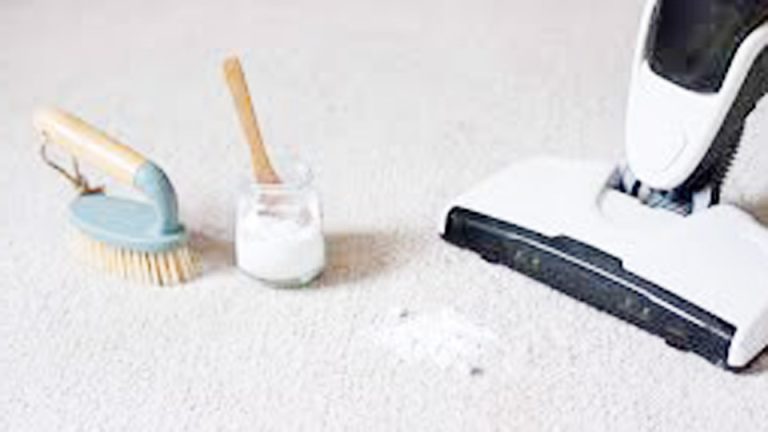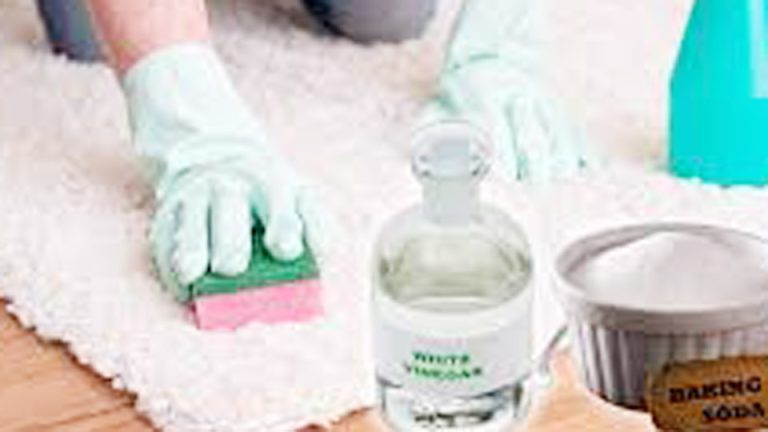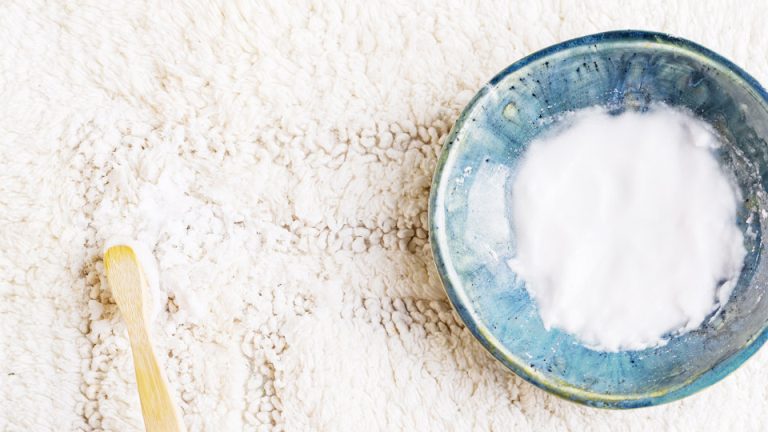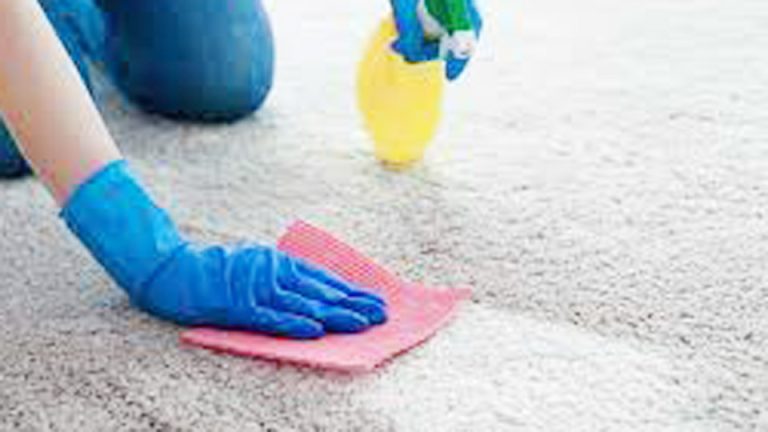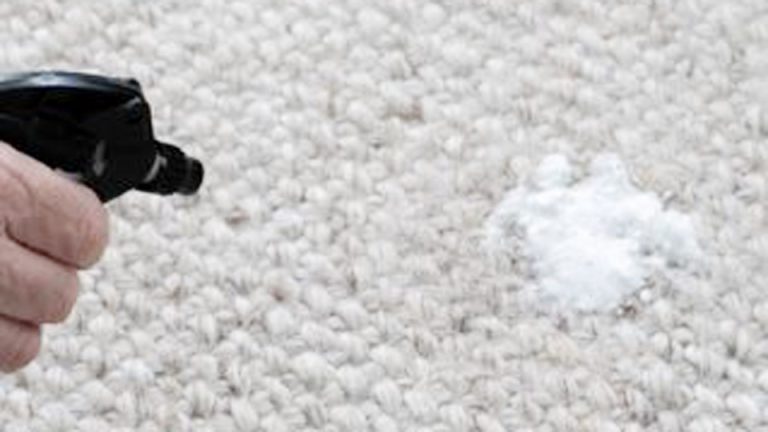There’s nothing quite like the sinking feeling of spotting a stain on your favorite rug. Whether it’s a splash of coffee from a busy morning or a muddy paw print from your furry friend, those blemishes can feel like they’re mocking your efforts to keep a tidy home. As a home cleaning expert who’s tackled countless rug disasters, I’ve learned that knowing how to clean a rug with vinegar is a game-changer.
Vinegar is my go-to for its affordability, eco-friendliness, and stain-busting power. I’ve used it to revive everything from vintage wool rugs to modern synthetic ones, and I’m excited to share my step-by-step process with you. Let’s dive into this friendly, no-stress guide to make your rug look as good as new, with practical tips and personal stories to keep it relatable and fun.

Image by bhg
Why Vinegar Is a Rug-Cleaning Superstar
I discovered vinegar’s cleaning magic years ago when I spilled red wine on my beloved area rug during a book club night. In a panic, I grabbed the white vinegar from my kitchen, and it worked like a charm! Vinegar’s acetic acid breaks down tough stains, cuts through grease, and neutralizes odors, making it perfect for rugs.
It’s natural, safe for most homes, and costs pennies compared to fancy commercial cleaners. Plus, it’s versatile enough to handle everything from pet accidents to food spills. However, you need to use it correctly to avoid issues like residue or damage to delicate fibers. Let’s explore how to clean a rug with vinegar the right way, based on my years of trial and error.
Understanding Your Rug’s Needs
Before we start cleaning, let’s talk about your rug. I’ve cleaned all sorts of rugs—shaggy, flatwoven, wool, synthetic—and each one requires a slightly different approach. Here’s a quick rundown of common rug types and how they handle vinegar:
Wool Rugs: These are luxurious but delicate. Vinegar needs to be diluted and used sparingly to avoid fading or fiber damage.
Synthetic Rugs: Made from nylon or polyester, these are durable and can handle vinegar well, though over-wetting can cause issues.
Cotton or Jute Rugs: These natural fibers are absorbent, so you need to be cautious with moisture to prevent mold or shrinking.
Silk Rugs: Super delicate—vinegar is usually too harsh, so I avoid it unless I’m spot-testing carefully.
Check your rug’s care label or test a small, hidden area first. I learned this the hard way when I used too much vinegar on a cotton rug and ended up with a slightly stiff patch. Knowing your rug’s material helps you clean confidently without risking damage.
Gathering Your Cleaning Supplies
To clean a rug with vinegar, you’ll need a few simple tools. I keep these in a cleaning caddy for quick access during spill emergencies. Here’s what I use:
- White vinegar: Stick to clear, distilled vinegar—apple cider vinegar can leave a sticky residue.
- Cold water: Warm water can set some stains, so cold is best.
- Clean white cloths or paper towels: These prevent dye transfer while blotting.
- Spray bottle: For applying your vinegar solution evenly.
- Soft-bristled brush: To gently work out stains without harming fibers.
- Baking soda: Optional for tougher stains or odors—it pairs beautifully with vinegar.
- Small bowl or bucket: For mixing solutions or soaking cloths.
- Dry towel: To absorb moisture after cleaning.
- Vacuum cleaner: To fluff up the rug’s fibers post-cleaning.
- Fan (optional): To speed up drying and prevent mold.
These items are likely already in your home, making this a budget-friendly cleaning method.
Step-by-Step Guide to Cleaning Fresh Stains with Vinegar
Fresh stains are the easiest to tackle, and acting fast is key. I once spilled a smoothie on my living room rug during a kid’s playdate, and this method saved the day. Here’s how to clean a fresh stain with vinegar:
Blot the Spill Immediately
As soon as a spill happens, grab a clean white cloth or paper towels. I always keep a stack of old washcloths handy for moments like these. Blot the stain gently—never rub, as that pushes the mess deeper into the rug’s fibers.
Press down firmly to soak up as much liquid as possible. Keep switching to a clean section of the cloth until you’re not picking up much more of the spill. This step is crucial to prevent the stain from spreading.
Mix and Apply a Vinegar Solution
In a spray bottle, mix one part white vinegar with one part cold water. I love this 1:1 ratio because it’s strong enough to tackle stains but gentle on most rugs. Lightly spritz the stained area—don’t drench it, as too much liquid can seep into the rug’s backing and cause mold.
Let the solution sit for 5-10 minutes to break down the stain. For greasy stains, like butter or salad dressing, I sometimes add a drop of mild dish soap to the mix for extra cleaning power.
Blot Again
After letting the vinegar sit, blot the area with a clean cloth to lift the stain. Work from the outside of the stain toward the center to keep it contained. You might need to switch to a fresh cloth if the stain is large. I’ve found that patience here pays off—keep blotting until the stain starts to fade.
Rinse Thoroughly
To avoid residue, rinse the area by spritzing it with plain cold water. Blot thoroughly to remove the vinegar and any loosened stain particles. I learned early on that skipping this step can leave a sticky residue that attracts dirt. Keep blotting until the rug feels only slightly damp.
Dry the Rug
Press a dry towel over the area to absorb excess moisture. I sometimes place a heavy book on the towel for an hour to soak up every last drop. If you have a fan, set it up to blow air over the spot to speed up drying. Once it’s dry, vacuum the area to restore the rug’s texture. Your rug should look fresh and clean!
Tackling Set-In Stains with Vinegar and Baking Soda
For older, dried stains, vinegar alone might need a boost. I once found a dried coffee stain under my coffee table, and pairing vinegar with baking soda worked wonders. Here’s how to handle set-in stains:
Loosen the Stain
Start by lightly dampening the stain with cold water using a spray bottle. This softens the dried mess. Then, sprinkle a thin layer of baking soda over the stain. I love baking soda for its ability to absorb odors and lift caked-on stains. Let it sit for a few minutes to start breaking down the stain.
Apply Vinegar and Let It Fizz
Spritz your 1:1 vinegar-water solution over the baking soda. You’ll see it fizz, which is the reaction that lifts the stain. I let this sit for 15-20 minutes for tough stains, but I avoid leaving it longer to prevent residue or moisture issues. If the stain is greasy, like from makeup, I add a drop of dish soap to the vinegar mix.
Gently Work the Stain
For stubborn stains, I use a soft-bristled brush to gently work the solution into the rug. Be gentle to avoid fraying the fibers, especially on wool or cotton rugs. I once got too enthusiastic with a brush on a jute rug and regretted it—light pressure is key.
Blot and Rinse
Blot the area with a clean cloth to lift the stain and residue. You might need to repeat the vinegar and baking soda steps a couple of times—I’ve done this for old pet stains, and it’s worth the effort. Rinse with cold water and blot thoroughly to remove all residue. This step ensures your rug stays vibrant and residue-free.
Dry Completely
Dry the area with a towel, using pressure to soak up moisture. A fan or open window helps speed up drying, especially for thick rugs. Vacuum once it’s dry to fluff up the fibers. Your rug will look revitalized!
Deep Cleaning a Rug with Vinegar
Sometimes, your rug needs more than spot cleaning—it needs a full refresh. I do this once or twice a year for my high-traffic living room rug. Here’s how to deep clean a rug with vinegar:
Vacuum Thoroughly
Start by vacuuming both sides of the rug to remove loose dirt and dust. I flip my rug over to get the underside, as dirt can hide there and grind into the fibers over time.
Prepare a Vinegar Solution
Mix one cup of white vinegar with one gallon of cold water in a bucket. This diluted solution is gentle enough for most rugs but still effective for cleaning. For small rugs, you can use a spray bottle with a 1:1 vinegar-water mix.
Spot-Test First
Before cleaning the whole rug, test the solution on a small, hidden area. I dab a cloth with the solution, apply it, and wait 10 minutes to check for fading or damage. This saved me once when I realized a vintage rug couldn’t handle vinegar.
Clean the Rug
For small rugs, dip a clean cloth or sponge into the solution and gently wipe the surface, working in small sections. For larger rugs, use a spray bottle to mist the solution lightly, then blot with a cloth. I work in a grid pattern to ensure I don’t miss any spots. Avoid soaking the rug to prevent mold or damage to the backing.
Rinse and Dry
Rinse the rug by wiping it with a cloth dipped in plain cold water. Blot thoroughly to remove the vinegar solution. Hang the rug outside to air-dry if possible, or use fans indoors to speed up drying. I once dried a rug on my balcony, and it smelled so fresh afterward! Vacuum once dry to restore the rug’s texture.
Comparing Vinegar to Other Cleaning Solutions
Vinegar is fantastic, but it’s not the only option for rug cleaning. Here’s a table comparing it to other household solutions I’ve used:
| Cleaning Solution | Pros | Cons | Best For |
|---|---|---|---|
| Vinegar + Water | Natural, effective on organic stains, odor-neutralizing | Can leave residue if not rinsed, strong smell during use | Coffee, wine, pet stains |
| Dish Soap + Water | Cuts grease, safe for most rugs, readily available | May leave residue if not rinsed, less effective on odors | Grease, food stains |
| Baking Soda | Absorbs odors, lifts dried stains, inexpensive | Messy if overused, not a standalone solution | Odors, dried stains |
| Club Soda | Good for fresh spills, minimal residue | Less effective on set-in stains, doesn’t tackle odors | Fresh spills, light stains |
Vinegar is my top choice for organic stains like juice or pet messes, but for greasy stains, I sometimes pair it with dish soap for the best results.
Rug Type Considerations
Different rugs need different care when using vinegar. Here’s how I adjust my approach:
Wool Rugs
Wool is delicate, so I use a weaker vinegar solution (1:2 with water) and limit soak time to 10 minutes. I rinse thoroughly to avoid residue or fading.
Synthetic Rugs
Nylon and polyester are durable, so a 1:1 vinegar solution works well. I just ensure thorough drying to prevent mold in the backing.
Cotton or Jute Rugs
These absorb moisture easily, so I use minimal liquid and dry quickly with a fan or outdoors. Over-wetting can cause shrinking or mold.
Silk Rugs
Silk is too delicate for vinegar in most cases. I stick to dry cleaning or consult a professional to avoid damage.
Preventing Rug Stains Before They Happen
Once your rug is clean, you’ll want to keep it that way. Here are my favorite preventative tips:
Act Fast on Spills
The sooner you tackle a spill, the less likely it is to set. I keep a cleaning caddy with cloths, vinegar, and a spray bottle near my living room for quick action.
Use Washable Mats
Place mats in high-spill areas, like under coffee tables or near entryways. I have a washable rug by my front door that catches muddy footprints.
Apply a Rug Protector
A spray like Scotchgard creates a stain-resistant barrier. I apply it every six months, and it makes cleaning so much easier.
Vacuum Regularly
Vacuum weekly to prevent dirt from mixing with spills and creating tougher stains. I also shake out smaller rugs outside to remove dust.
Extra Cleaning Hacks I Love
Here are a few tricks I’ve picked up to make rug cleaning easier:
Ice for Sticky Spills: For gum or candy, place ice cubes on the spot to harden it, then scrape gently before applying vinegar.
Baking Soda for Odors: Sprinkle baking soda on pet stains, let it sit for 10 minutes, then vacuum. It’s a lifesaver for pet-friendly homes.
DIY Stain Spray: Keep a spray bottle with a 1:1 vinegar-water mix in your caddy for instant spot cleaning.
You’re Ready to Keep Your Rug Spotless!
Cleaning a rug with vinegar is like having a secret weapon in your cleaning arsenal. I’ve used this method to save rugs from all sorts of messes, and it never fails to impress me. With my step-by-step guide, you can tackle stains and refresh your rugs with confidence.
Your home deserves to shine, and you’ve got the tools and know-how to make it happen. So grab that vinegar, roll up your sleeves, and show those rug stains who’s boss!
Frequently Asked Questions
Can I use apple cider vinegar instead of white vinegar to clean my rug?
I don’t recommend apple cider vinegar, as it’s darker and can leave a sticky residue. White vinegar is clearer and more effective for rug cleaning.
Will vinegar damage my wool rug?
Wool is delicate, so I use a diluted vinegar solution (1:2 with water) and limit soak time to 10 minutes. Always rinse thoroughly and test a small area first.
How long should I let vinegar sit on a rug stain?
I let vinegar sit for 5-20 minutes, depending on the stain. Longer than 30 minutes can risk residue or moisture issues, so I set a timer to stay safe.
Is vinegar safe for pet stains on rugs?
Yes, vinegar is great for neutralizing pet odors and lifting stains. I rinse thoroughly and dry completely to avoid residue or mold in pet-friendly homes.
What if my rug smells like vinegar after cleaning?
The vinegar smell fades as the rug dries. I speed up drying with a fan and sprinkle baking soda before vacuuming to neutralize any lingering odor.

